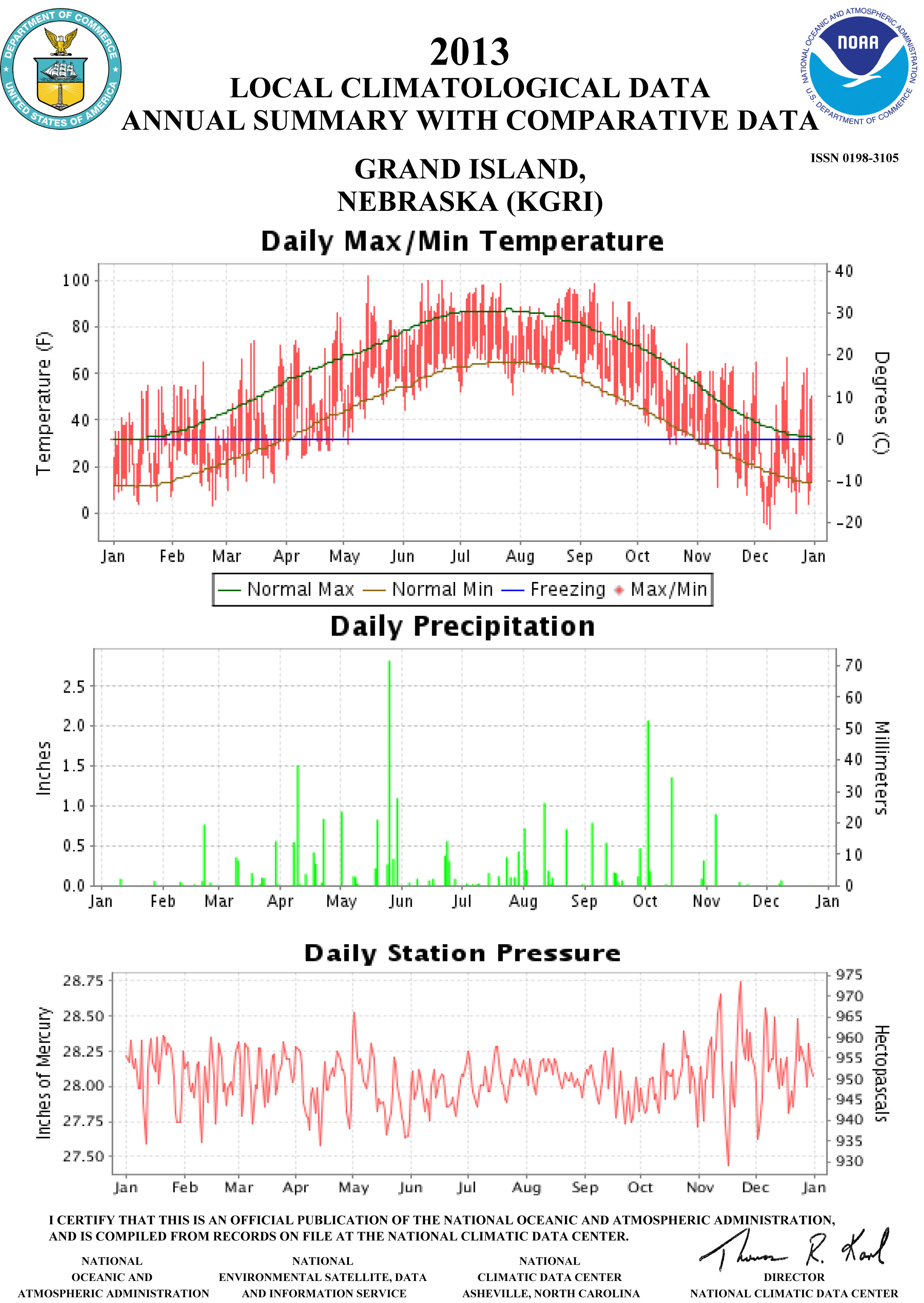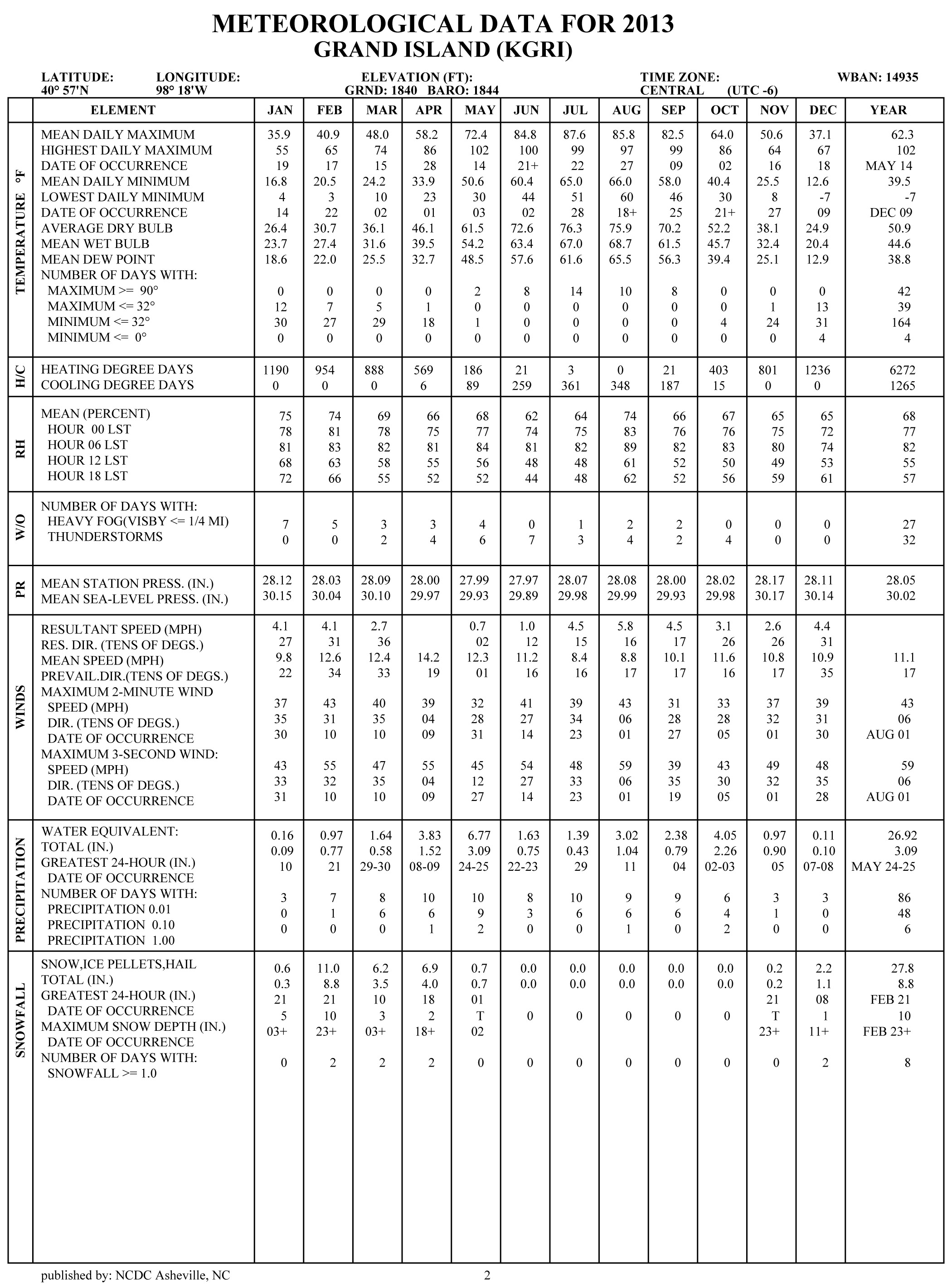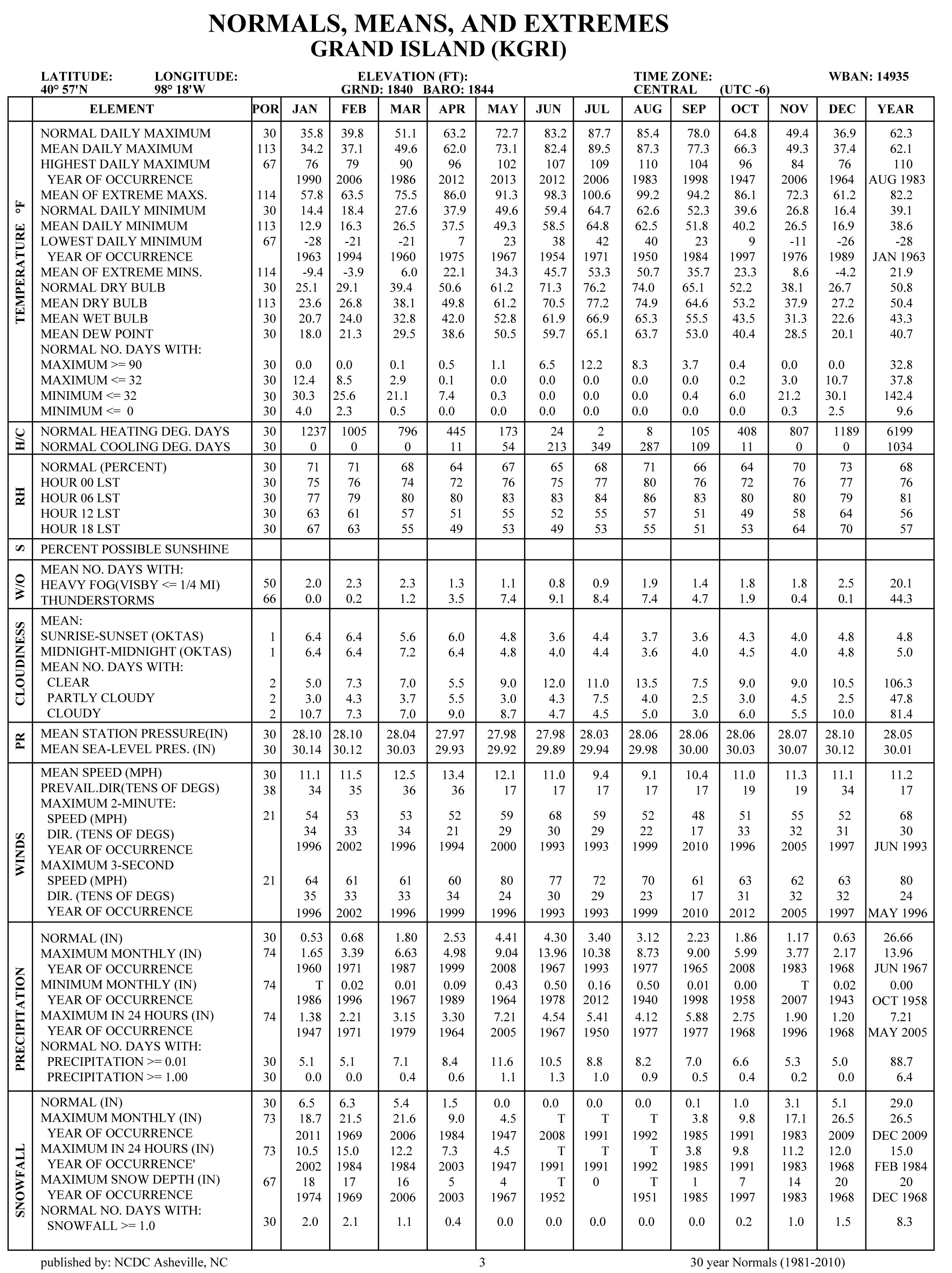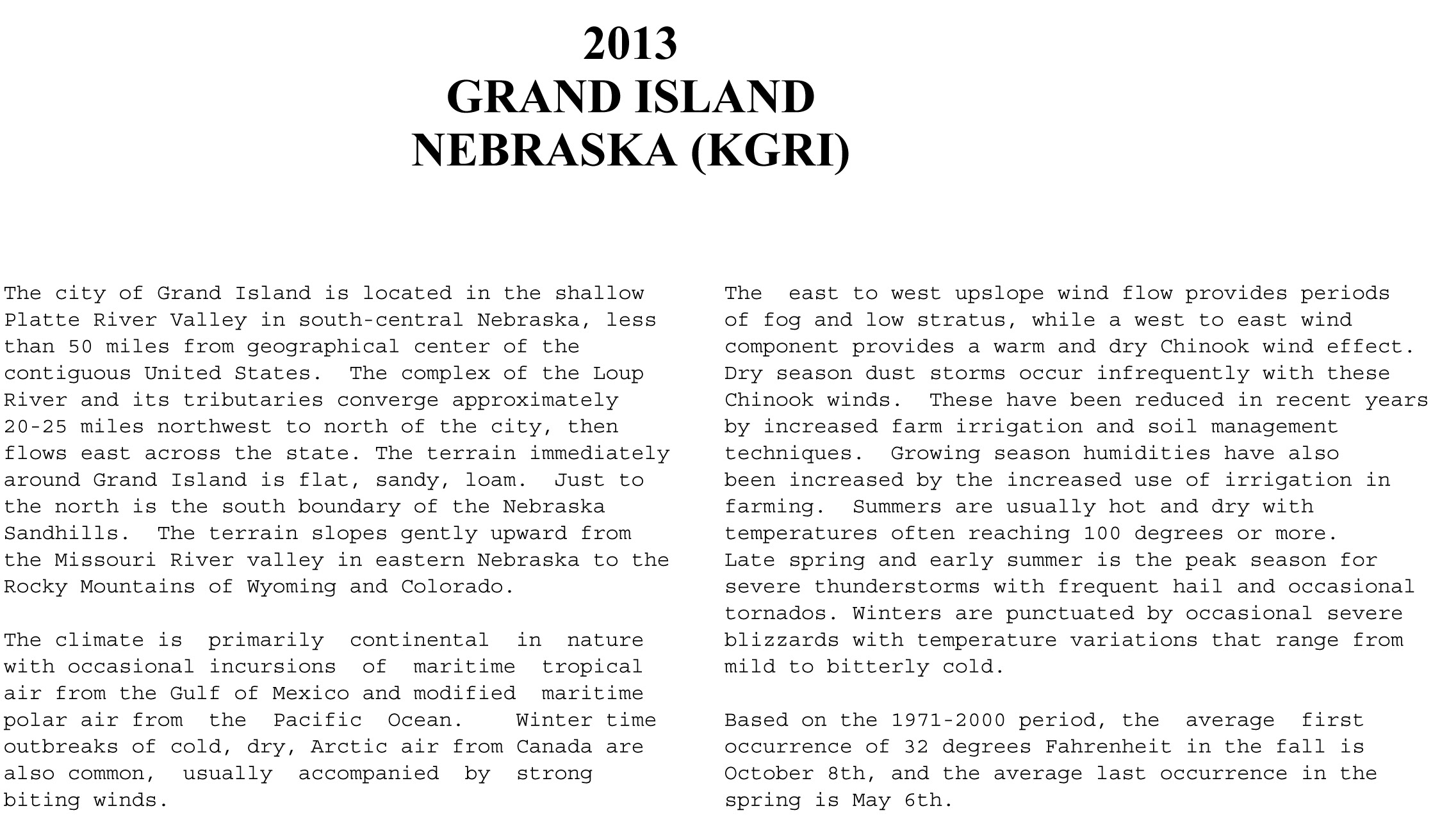local climate data
Objectives:
Climate data are extremely useful for numerous purposes. Farmers use their knowledge of weather and climate over a long period to determine what crops to plant and for guidance on when to plant and when to harvest. Utilities use climate data for planning production and distribution of energy supplies and the reallocation among types of such supplies. The building industry uses climate data in the design of structures, including their necessary strength, heating and cooling energy requirements, and the associated building codes that regulate them. People look to climate data as they plan future events or activities (e.g., outdoor gatherings, vacations, and sporting events). These are just a few of the multitude of uses for climate data.
In the U.S., weather data are gathered by NOAA’s National Weather Service offices and other organizations and compiled at state, regional, and national centers for distribution to users. NOAA’s National Climatic Data Center in Asheville, NC is responsible for compiling U.S. data as well as being a depository for much of the worldwide data on weather and the environment. This information, in turn, is made available to users in print, CD-ROM, and online formats.
After completing this investigation, you should be able to:
Interpret information appearing in Local Climatic Data, Annual Summary with Comparative Data based on weather data collected at a local National Weather Service office.
Determine how to access archived climate data from the National Climatic Data Center (NCDC).
Introduction:
A basic publication of the National Climatic Data Center based on weather data from local National Weather Service (NWS) offices is the Local Climatological Data (LCD). It is published in monthly and annual summaries. LCDs are published for about 275 NWS observing sites. Portions of the LCD, Annual Summary with Comparative Data, for Grand Island, Nebraska (KGRI) for the year 2013 are used in this investigation. Grand Island is located near the geographic center of the coterminous United States. For a copy of a monthly or annual LCD, go to: http://www7.ncdc.noaa.gov/IPS/lcd/lcd.html (), then select the state (click NEXT), followed by the station, and finally the YEAR-MO or YEAR-ANNUAL. Then click on the URL to download the pdf document (monthly data also is provided in text format).
1. Examine the temperature graph appearing on the report’s front page (Figure 1). Daily temperature ranges are plotted as vertical lines on the graph. The top end of each line signifies the maximum daily temperature and the bottom end reports the day’s minimum temperature. Assuming that frost occurs if the temperature falls to 32 °F or lower, the approximate date of the last spring frost in 2013 at Grand Island when the minimum temperature dropped to 30 °F was about [(3)(10)(18)] May.

Figure 1. Local Climatological Data, Annual Summary, Grand Island, NE, 2013 cover.
2. The date of the year’s first fall frost was about [(5)(17)(24)] October.
Examine page 2 of the LCD, Annual Summary (Figure 2) entitled, “Meteorological Data for 2013” and answer the following questions about Grand Island, NE:

Figure 2. Grand Island Meteorological Data for 2013.
3. What month had the lowest average temperature (“Average Dry Bulb”)? [(December)(January)(February)]
4. What was the average temperature that month? [(9.9)(18.6)(21.6)(24.9)] °F.
5. What month had the highest average temperature? [(June)(July)(August)]
6. What was that temperature? [(72.5)(76.3)(84.4)(98.4)] °F
7. How many days in the year had temperatures of 90 °F or higher? [(9)(14)(28)(42)]
8. How many had temperatures of 0 °F or lower? [(4)(9)(19)(35)]
9. In 2013, Grand Island experienced about [(2)(5)(10)] times more Heating Degree Days than Cooling Degree Days.
10. On how many days in the year were thunderstorms reported? [(6)(21)(32)(53)]
11. The strongest gust of wind, as reported in the Maximum 3-Second Wind category was a speed of [(41)(59)(74)(86)] mph.
12. This occurred during 2013 in the month of [(March)(May)(August)(September)].
13. The total precipitation for the year (Water Equivalent: Total) was about [(9)(14)(27)(43)] inches.
14. The total number of days when there was at least a trace of precipitation (equal to or greater than 0.01 in.) was [(9)(25)(86)(107)].
15. The total number of days in 2013 where an inch or more of snow had fallen was [(4)(8)(13)(22)].
Examine page 3 of the LCD, Annual Summary (Figure 3) entitled “NORMALS, MEANS, AND EXTREMES”. “Normals” are averages of individual weather elements over a fixed period of time, usually 30 years. Normals for this LCD were based on 1981-2010. “Mean” values are averages for the entire period of record of the weather element. Respond to the following:

Figure 3. Grand Island LCD Normals, Means, and Extremes.
16. The normal monthly temperatures (Normal Dry Bulb) range from a low of 25.1 °F in January to a high of [(76.2)(78.5)(81.6)(87.4)] °F in the month of July in Grand Island, NE.
17. The Highest Daily Maximum temperature ever recorded at Grand Island was [(99)(107)(110)(111)] °F in August 1983.
18. The mean number of days per year with thunderstorms is [(23.5)(32.4)(44.3)(56.8)].
19. Over the year the mean wind speed is [(11.2)(11.8)(12.5)(13.8)] mph from a direction coded as 17 (tens of degrees measured clockwise from north), meaning essentially from the south. [Wind from due south would be coded as 18.]
20. The normal yearly total precipitation is [(17.44)(21.52)(23.22)(26.66)] inches.
21. This is [(much less than)(nearly equal to)(much more than)] the total for 2013.
22. Also included as part of the LCD, Annual Summary is a brief narrative describing the location and climatic aspects of the area surrounding the local NWS office. According to the Grand Island description in Figure 4, its climate is described as primarily [(“maritime”)(“continental”)] in nature.

Figure 4. 2013 Grand Island (KGRI).
23. Incursions of maritime tropical air from the Gulf of Mexico [(do)(do not)] make it to Grand Island.
24. Grand Island’s east to west upslope terrain produces episodes of [(dust storms)(blizzards)(fog and low stratus clouds)] when winds are from the east.
As directed by your course instructor, complete this investigation by either:
- Going to the Current Weather Studies link on the course website, or
- Continuing the Applications section for this investigation that immediately follows.
Investigation 15B: Applications
In addition to the Local Climatic Data, Annual Summary, there is the Local Climatic Data, (Edited), LCD, Monthly Publication available from the National Climatic Data Center. This publication contains daily information on a 3-hour basis for each month. A sample copy can be viewed at http://www7.ncdc.noaa.gov/IPS/lcd/lcd.html (). (Adobe Acrobat Reader required.)
25. Most National Weather Service (NWS) offices also post a monthly climatological summary on their website. Figure 5 is a sample from Grand Island for February [(2010)(2011)(2012)(2013)].
Climatological Report (Monthly)
|
CLIMATE REPORT |
|
NATIONAL WEATHER SERVICE HASTINGS NE |
|
1128 PM CST FRI MAR 1 2013 |
|
...THE GRAND ISLAND NE CLIMATE SUMMARY FOR THE MONTH OF FEBRUARY 2013... |
|
CLIMATE NORMAL PERIOD 1981 TO 2010 |
|
CLIMATE RECORD PERIOD 1895 TO 2013 |
|
WEATHER |
OBSERVED VALUE |
DATE(S) |
NORMAL VALUE |
DEPART FROM NORMAL |
LAST VALUE |
YEAR` DATE(S) |
|
................................................................ |
||||||
|
TEMPERATURE (F) |
||||||
|
RECORD |
||||||
|
HIGH |
80 |
02/25/1995 |
||||
|
LOW |
-34 |
02/12/1899 |
||||
|
HIGHEST |
65 |
02/17 |
65 |
0 |
61 |
02/01 |
|
LOWEST |
3 |
02/22 |
-4 |
7 |
-7 |
02/11 |
|
AVG. MAXIMUM |
40.9 |
39.8 |
1.1 |
40.9 |
||
|
AVG. MINIMUM |
20.5 |
18.4 |
2.1 |
19.3 |
||
|
MEAN |
30.7 |
29.1 |
1.6 |
30.1 |
||
|
DAYS MAX >= 90 |
0 |
0.0 |
0.0 |
0 |
||
|
DAYS MAX <= 32 |
7 |
8.5 |
-1.5 |
7 |
||
|
DAYS MIN <= 32 |
27 |
25.6 |
1.4 |
26 |
||
|
DAYS MIN <= 0 |
0 |
2.3 |
-2.3 |
2 |
||
|
PRECIPITATION (IN.) |
||||||
|
RECORD |
||||||
|
MAXIMUM |
4.39 |
1903 |
||||
|
MINIMUM |
0.01 |
1904 |
||||
|
TOTALS |
0.97 |
0.68 |
0.29 |
1.05 |
||
|
DAILY AVG. |
0.03 |
0.02 |
0.01 |
0.04 |
||
|
DAYS >= .01 |
7 |
5.1 |
1.9 |
7 |
||
|
DAYS >=. 10 |
1 |
2.1 |
-1.1 |
2 |
||
|
DAYS >= .50 |
1 |
0.2 |
0.8 |
1 |
||
|
DAYS >= 1.00 |
0 |
0.0 |
0.0 |
0 |
||
|
GREATEST |
||||||
|
24HR. TOTAL |
0.77 |
02/21TO02/21 |
||||
|
SNOWFALL (IN.) |
||||||
|
RECORDS |
||||||
|
TOTAL |
29.7 |
1915 |
||||
|
TOTALS |
11.0 |
6.3 |
4.7 |
10.2 |
||
|
SINCE7/1 |
21.4 |
22.1 |
-0.7 |
20.1 |
||
|
SNOW DEPTH AVG. |
2 |
3 |
-1 |
3 |
||
|
DAYS >= 1.0 |
2 |
2.1 |
-0.1 |
2 |
||
|
GREATEST |
||||||
|
SNOW DEPTH |
10 |
02/23 |
9 |
02/04 |
||
|
02/22 |
||||||
|
DEGREE_DAYS |
||||||
|
HEATING TOTAL |
954 |
1005 |
-51 |
1007 |
||
|
SINCE 7/1 |
4469 |
4761 |
-292 |
4346 |
||
|
COOLING TOTAL |
0 |
0 |
0 |
0 |
||
|
SINCE 1/1 |
0 |
0 |
0 |
0 |
||
.................................................................
|
WIND (MPH) |
|||
|
AVERAGE WIND SPEED |
12.6 |
||
|
HIGHEST WIND SPEED/DIRECTION |
43/310 |
DATE |
02/10 |
|
HIGHEST GUST SPEED/DIRECTION |
55/320 |
DATE |
02/10 |
|
SKY COVER |
|||
|
POSSIBLE SUNSHINE (PERCENT) |
MM |
||
|
NUMBER OF DAYS FAIR |
15 |
||
|
NUMBER OF DAYS PC |
7 |
||
|
NUMBER OF DAYS CLOUDY |
6 |
||
|
AVERAGE RH (PERCENT) |
71 |
||
|
WEATHER CONDITIONS. NUMBER OF DAYS WITH |
|||
|
THUNDERSTORM |
0 |
MIXED PRECIP |
0 |
|
HEAVY RAIN |
0 |
RAIN |
0 |
|
LIGHT RAIN |
2 |
FREEZING RAIN |
0 |
|
LT FREEZING RAIN |
0 |
HAIL |
0 |
|
HEAVY SNOW |
1 |
SNOW |
1 |
|
LIGHT SNOW |
10 |
SLEET |
0 |
|
FOG |
12 |
FOG W/VIS <= 1/4 MILE |
5 |
|
HAZE |
1 |
||
|
- |
INDICATES NEGATIVE NUMBERS. |
|
R |
INDICATES RECORD WAS SET OR TIED. |
|
MM |
INDICATES DATA IS MISSING. |
|
T |
INDICATES TRACE AMOUNT. |
|
&& |
|
..FEBRUARY 2013 SUMMARY FOR CENTRAL NEBRASKA REGIONAL AIRPORT... |
|
...TEMPERATURES |
|
ONE DAILY TEMPERATURE RECORD SET IN FEB. 2013: |
|
FEB. 6: RECORD WARM LOW TEMPERATURE OF 34 (PREVIOUS 31 IN 1930) |
|
...FEBRUARY 2013 NARRATIVE FOR CENTRAL NEBRASKA REGIONAL AIRPORT... |
|
FOR THE SECOND TIME IN THREE MONTHS...GRAND ISLAND RECORDED ABOVE |
|
NORMAL PRECIPITATION...AT LEAST PUTTING A SMALL DENT IN THE ONGOING |
|
EXTREME TO EXCEPTIONAL DROUGHT SITUATION PER THE U.S. DROUGHT |
|
MONITOR. TEMPERATURE-WISE...THE MONTH AS A WHOLE ENDED UP ONLY |
|
SLIGHTLY ABOVE NORMAL...BUT STARTED QUITE WARM AND ENDED RATHER |
|
COLD. |
Figure 5. Climatological Report (Monthly) [WS Product: CLM] for Grand Island, Nebraska for February 2013 (abridged).
26. NWS offices reporting monthly climatological data typically follow the same format (WS Product CLM) as shown in Figure 5. For the month, data concerning record (if any), high/low, and average temperatures, record and total precipitation, wind, etc., are reported in a table. From the table, it can be seen that during the month reported, the highest temperature (“HIGHEST”) was [(45)(57)(65)(76)] °F.
27. This high occurred on the seventeenth of the month and was [(0)(3)(7)(11)] degrees above normal.
28. The average monthly temperature [“MEAN”]) was [(19.4)(28.9)(30.7)(38.4)] °F.
29. The total snowfall for the month [“TOTALS”], (following the RECORDS TOTAL entry) was [(0.3)(1.9)(5.4)(11.0)] in.
30. The total number of heating-degree days (“DEGREE DAYS, HEATING TOTAL”) for the month was [(679)(794)(954)(1061)].
Visit the website of the NWS Forecast Office nearest you that reports monthly local climatological data in a format similar to that shown in this investigation’s example. To find the NWS office near you, go to: http://www.wrh.noaa.gov/wrh/forecastoffice_tab.php ().
Click on one of the locations appearing on the map. The NWS Weather Forecast Office website you call up will have a left-side menu which includes the term “Climate”. Under “Climate”, click on “Local” to view monthly summaries. Most NWS offices post the most recent monthly summaries covering the period of a year or more. Call up and print out a copy for the most recent full month reported for possible future reference.
Suggestions for further activities: The National Climatic Data Center provides many types of free climatic data, a portion of which is provided from their website (http://www.ncdc.noaa.gov/oa/climate/climatedata.html ()).